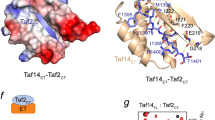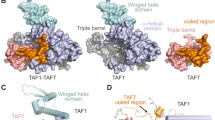Abstract
The HIV-1 Tat protein is an RNA-binding transcriptional transactivator. Recent findings suggest that Tat associates with a cellular kinase that phosphorylates the carboxyl-terminal domain of the largest subunit of RNA polymerase II. Here we review, in brief, the role of Tat-associated kinase in Tat-activated transcription. We discuss evidence that suggests involvement of TFIIH and/or P-TEFb.
Similar content being viewed by others
References
Benkirane M, Neuveut C, Chun RF, Smith SM, Samuel CE, Gatignol A, Jeang KT. Oncogenic potential of TAR RNA binding protein TRBP and its regulatory interaction with RNA-dependent protein kinase PKR. EMBO J 16(3):611–624;1997.
Berkhout B, Gatignol A, Rabson AB, Jeang KT. TAR-independent activation of the HIV-1 LTR: Evidence that Tat requires specific regions of the promoter. Cell 62:7257–7267;1990.
Berkhout B, Jeang KT. Functional roles for the TATA promoter and enhancers in basal and Tat-induced expression of the human immunodeficiency virus type 1 long terminal repeat. J Virol 66:139–149;1992.
Berkhout B, Silverman RH, Jeang KT. Tattrans-activates the human immunodeficiency virus through a nascent RNA target. Cell 59:273–282;1989.
Bohan CB, Kashanchi F, Ensoli B, Buongaguro B, Boris-Lawrie KA, Brady JN. Analysis of Tat transactivation of human immunodeficiency virus transcription in vitro. Gene Expr 2(4):391–407;1992.
Calnan BJ, Tidor BT, Biancalana S, Hudson D, Franel AD. Arginine-mediated RNA recognition: The arginine fork. Science 252:1167–1171;1991.
Chun RF, Jeang KT. Requirements for RNA polymerase II carboxyl-terminal domain for activated transcription of human retroviruses human T-cell lymphotropic virus I and HIV-1. J Biol Chem 271(44):27888–27894;1996.
Conaway RC, Conaway JW. Transcription inititated by RNA polymerase II and purified transcription factors from liver. J Biol Chem 265(13):7559–7563;1990.
Cujec TP, Cho H, Maldonado E, Meyer J, Reinberg D, Peterlin BM. The human immunodeficiency virus type transactivator Tat interacts with the RNA polymerase II holoenzyme. Mol Cell Biol 17:1817–1823;1997.
Cujec TP, Okamoto H, Fujinaga K, Meyer J, Chamberlin H, Morgan D, Peterlin BM. The HIV transactivator TAT binds to the CDK-activating kinase and activates the phosphorylation of the carboxy-terminal domain of RNA polymerase II. Genes Dev 11:2645–2657;1997.
Dayton A, Sodroski J, Rosen C, Goh W, Haseltine W. The transactivator gene of the human T cell lymphotropic virus type III is required for replication. Cell 44:941–947;1986.
Dingwall C, Ernberg I, Gait MJ, Green SM, Heaphy S, Karn J, Lowe AD, Singh M, Skinner MA, Vallerio R. Human immunodeficiency virus 1 tat protein bindstrans-activation responsive region (TAR) RNA in vitro. Proc Natl Acad Sci USA 86:6925–6929;1989.
Dvir A, Conaway RC, Conaway JW. A role for TFIIH in controlling the activity of early RNA polymerase II elongation complexes. Proc Natl Acad Sci USA 94:9006–9010;1997.
Dvir A, Garrett KP, Chalut C, Egly JM, Conaway JW, Conaway RC. A role for ATP and TFIIH in activation of the RNA polymerase II preinitiation complex prior to transcription initiation. J Biol Chem 271(13):7245–7248;1996.
Feinberg MB, Baltimore D, Frankel AD. The role of Tat in the human immunodeficiency virus type life cycle indicates a primary effect of transcriptional elongation. Proc Natl Acad Sci USA 88(9):4045–4049;1991.
Fisher A, Feinberg M, Josephs M, Harper M, Marselle L, Reyers G, Gonda M, Aldovini A, Debouk C, Gallo RC, Wong-Staal F. The transactivator gene for HTLV-III is essential for virus replication. Nature 320:367–371;1986.
Garcia-Martinex LF, Mavankal G, Neveu JM, Lane WS, Ivanov D, Ganynor RB. Purification of a Tat-associated kinase reveals a TFIIH complex that modulates HIV-1 transcription. EMBO 16(10):2836–2850;1997.
Gatignol A, Buckler A, Berkhout B, Jeang KT. Characterization of human TAR RNA-binding protein that activates the HIV-1 LTR. Science 251:1597–1600;1991.
Gatignol A, Buckler A, Jeang KT. Relatedness of an RNA-binding motif in human immunodeficiency virus type 1 TAR RNA-binding protein TRBP to human P1/dsI kinase andDrosophila staufen. Mol Cell Biol 13:2193–2202;1993.
Gatignol A, Duarte M, Daviet L, Chang YN, Jeang KT. Sequential steps in Tattrans-activation of HIV-1 mediated through cellular DNA, RNA, and protein binding factors. Gene Exp 5:217–228;1996.
Goodrich JA, Tjian R. Transcription factors IIE and IIH and ATP hydrolysis direct promoter clearance by RNA polymerase II. Cell 77:145–156;1994.
Herrmann CH, Rice AP. Specific interaction of the human immunodeficiency virus Tat proteins with a cellular protein kinase. Virology 197(2):601–608;1993.
Herrmann CH, Rice AP. Lentivirus Tat proteins specifically associate with a cellular protein kinase, TAK, that hyperphosphates the carboxylterminal domain of the large subunit of RNA polymerase II: Candidate for a Tat cofactor. J Virol 69:1612–1620;1995.
Holstege FCP, Van der Vliet PC, Marc Timmers HT. Opening of an RNA polymerase II promoter occurs in two distinct steps and requires the basal transcription factors IIE and IIH. EMBO J 15(7):1666–1677;1996.
Huang LM, Jeang KT. Increased spacing between Sp1 and TATAA renders human immunodeficiency virus type 1 replication defective: Implication of Tat function. J Virol 67:6937–6944;1993.
Jeang KT, Berkhout B. Kinetics of HIV-1 LTR transactivation: Use of intragenic ribozyme to assess rate limiting steps. J Biol Chem 267:17891–17899;1992.
Jeang KT, Berkhout B, Dropulic B. Effects of integration and replication on the transcription of the HIV-1 LTR. J Biol Chem 268:24949–24959;1993.
Jeang KT, Chun RF, Lin NH, Gatignol A, Glabe CG, Fan H. In vitro and in vivo binding of human immunodeficiency virus type 1 Tat protein and Sp1 transcription factor. J Virol 67:6224–6233;1993.
Jeang KT. HIV-1 Tat structure and function: In: Meyers G, Henderson LE, Korber B, Jeang KT, Wain-Hobson S, eds. Human Retroviruses and AIDS 1996, sect. 3, pp 3–18. Los Alamos National Laboratory, 1996.
Jones KA. Taking a new TAK on Tat transactivation. Genes Dev 11:2593–2599;1997.
Jones KA, Peterlin BM. Control of RNA initiation and elongation at the HIV-1 Promoter. Annu Rev Biochem 63:717–743;1994.
Kao SY, Calman AF, Luciw PA, Peterlin BM. Antitermination of transcription within the long terminal repeat of HIV-1 by tat gene product. Nature 330:489–493;1987.
Kashanchi F, Piras G, Radonovich MF, Duvall JF, Roeder R, Brady JN. Direct interaction of human TFIID with the HIV-1 transactivator tat. Nature 367:295–299;1994.
Keen NJ, Churcher MJ, Karn J. Transfer of Tat and release of TAR RNA during the activation of the human immunodeficiency virus type-1 transcription elongation complex. EMBO J 16(17):5250–5272;1997.
Laspia MF, Rice AP, Mathews MB. HIV-1 Tat protein increases transcriptional initiation and stabilizes elongation. Cell 59:283–292;1989.
Lint CV, Emiliani S, Ott M, Verdin E. Transcriptional activation and chromatin remodeling of the HIV-1 promoter in response to histone acetylation. EMBO J 15(5):1112–1120;1996.
Mancebo HSY, Lee G, Flygare H, Tomassini J, Luu P, Zhu Y, Peng J, Blau C, Hazuda D, Price D, Flores O. P-TEEb kinase is required for HIV Tat transcriptional activation in vivo and in vitro. Genes Dev 11:2633–2644;1997.
Marshall NF, Peng J, Xie Z, Price DH. Control of RNA polymerase II elongation potential by a novel carboxyl-terminal domain kinase. J Biol Chem 271(43):27176–27183;1996.
Muesing M, Smith D, Capon D. Regulation of mRNA accumulation by human immunodeficiency virustrans-activator protein. Cell 48:691–701;1987.
Neuveut C, Jeang KT. Recombinant human immunodeficiency virus type 1 genomes with tat unconstrained by overlapping reading frames reveal residues in Tat important for replication in tissue culture. J Virol 70:5572–5581;1996.
Okamoto O, Sheline CT, Corden JL, Jones KA, Peterlin BM.Trans-activation by human immunodeficiency virus Tat protein requires the C-terminal domain of RNA polymerase II. Proc Natl Acad Sci USA 93(21):11575–11579;1996.
Parada CA, Roeder RG. Enhanced processivity of RNA polymerase II triggered by Tat-induced phosphorylation of its carboxyl-terminal domain. Nature 384:375–377;1996.
Pazin MJ, Sheridan PL, Cannon K, Cao Z, Keck JG, Kadonaga JT, Jones KA. NF-kappaB-mediated chromatin reconfiguration and transcriptional activation of the HIV-1 enhancer in vitro. Genes Dev 10(1):37–49;1996.
Rosen CA, Sodroski JG, Haseltine WA. The location ofcis-acting regulatory sequences in the human T cell lymphotropic virus type III (HTLV-III/LAV) long terminal repeat. Cell 41(3):813–823;1985.
Sheline CT, Milocco LH, Jones KA. Two distinct nuclear transcription factors recognize loop and bulge residues of the HIV-1 TAR RNA hairpin. Genes Dev 5:2508–2610;1991.
Southgate CD, Green MR. The HIV-1 Tat protein activates transcription from an upstream DNA-binding site: Implications for Tat function. Genes Dev 5:2496–2507;1991.
Sune C, Garcia-Blanco MA. Sp1 transcription factor is required for in vitro basal and Tat-activated transcription from the human immunodeficiency virus type 1 long terminal repeat. J Virol 69(10):6572–6576;1995.
Svejstrup JQ, Vichi P, Egly JM. The multiple roles of transcription/repair factor TFIIH. Trends Biochem Sci 21:346–351;1996.
Verhoef K, Tijms M, Berkhout B. Optimal Tat-mediated activation of the HIV-1 LTR promoter requires a full-length TAR RNA hairpin. Nucleic Acids Res 25(3):496–502;1997.
Xiao H, Lis JT, Jeang KT. Promoter activity of Tat at steps subsequent to TATA-binding protein recruitment. Mol Cell Biol 17(12), 1997, in press.
Yang X, Herrmann CH, Rice AP. The human immunodeficiency virus Tat proteins specifically associate with TAK in vivo and require the carboxyl-terminal domain of RNA polymerase for function. J Virol 70(7):4576–4584;1996.
Yankulov K, Blau J, Purton T, Roberts S, Bentley DL. Transcriptional elongation by RNA polymerase II is stimulated by transactivators. Cell 77:749–759;1994.
Yankulov K, Yamashita K, Roy R, Egly JM, Bentley DL. The transcriptional elongation inhibitor 5,6-dichloro-1-beta-D-ribofuranosylbenzimidazole inhibits transcription factor IIH-associated protein kinase. J Biol Chem 270(41):23922–23925;1995.
Zawel L, Reinberg D. Common themes in assembly and function of eukaryotic transcription complexes. Annu Rev Biochem 64:533–561;1995.
Zhou Q, Sharp PA. Novel mechanism and factor for regulation by HIV-1 Tat. EMBO J 14(2):321–328;1995.
Zhou Q, Sharp PA. Tat-SF1: Cofactor for stimulation of transcriptional elongation by HIV-1 Tat. Science 274:605–609;1996.
Zhu Y, Pe'ery P, Peng J, Ramanathan Y, Marshall N, Marshall T, Amendt B, Mathews MB, Price DH. Transcription elongation factor P-TEFb is required of HIV-1 Tat transactivation in vitro. Genes Dev 11:2622–2632;1997.
Author information
Authors and Affiliations
Rights and permissions
About this article
Cite this article
Jeang, KT. Tat, Tat-associated kinase, and transcription. J Biomed Sci 5, 24–27 (1998). https://doi.org/10.1007/BF02253352
Received:
Accepted:
Issue Date:
DOI: https://doi.org/10.1007/BF02253352




